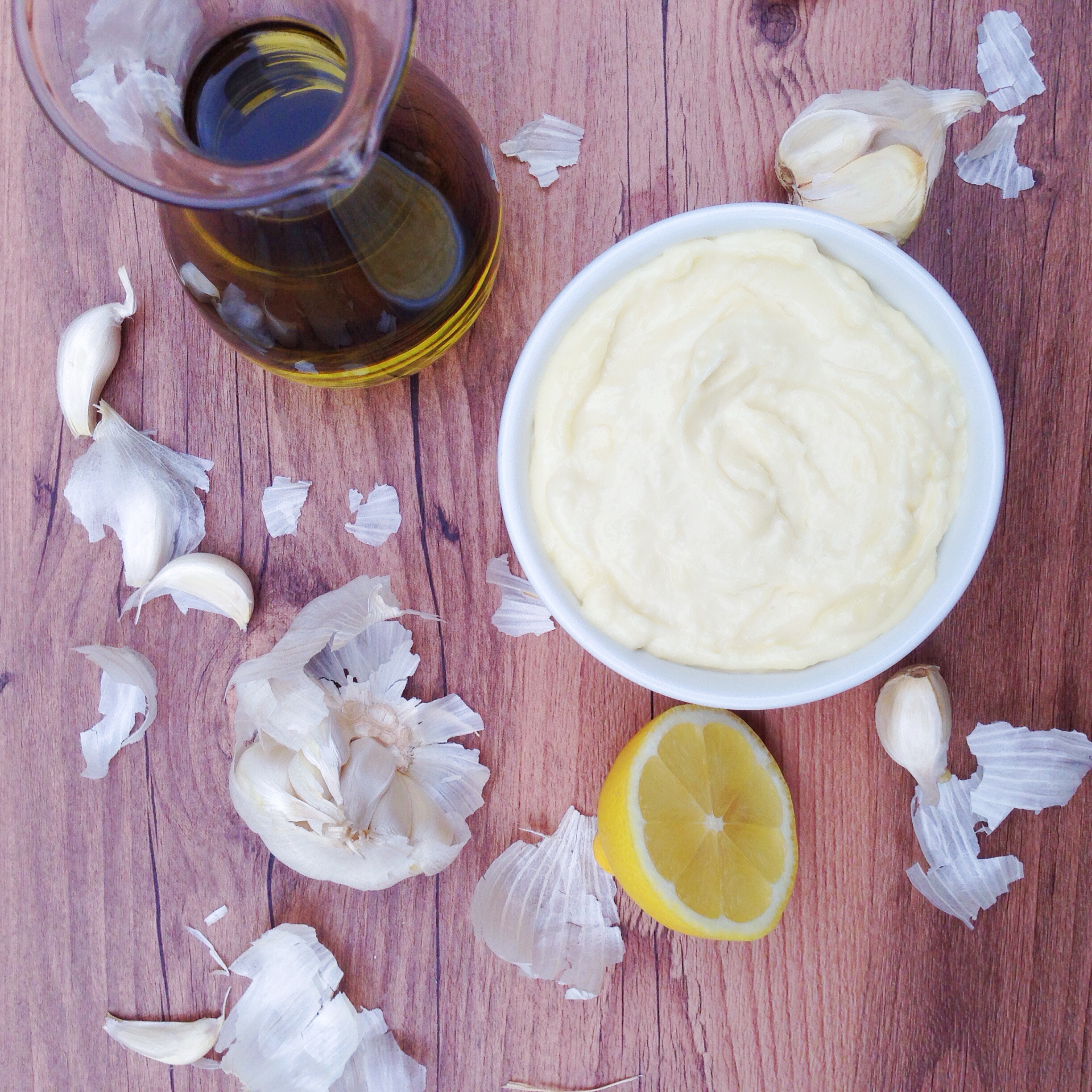Aioli / Aïoli (garlic sauce)
I have been trying to make aioli* for a long time. I started by preparing the lebanese version with garlic, olive oil, salt and little bit of lemon juice. I tested various methods available; all failed. Something was wrong from the very start: the garlic texture. I tried it with a mortar and pestle (with and without salt), the back of a knife, a food processor, a garlic press… nothing worked. The garlic was nicely “crushed” but once I started adding olive oil, it just separated and I ended up with soups of different textures, all very garlicky but miles away from the aioli I wanted to achieve.
Then came the microplane** rasp grater! It is a super fine grater with extremely sharp blades. The grated garlic will come out smooth with a nice pasty texture. That was the first step. Garlic texture: done!
I decided to work by hand in a large bowl and to make things step by step trying to find a solution to every problem I encountered.
I was told to instantly add lemon juice to the grated garlic in order for the aioli to stay white. The texture turned bad and my numerous aioli trials failed. Maybe it was never the right amount of lemon juice but it didn’t work for me. (People who give bad advices should be punished!)
I learned that one of the salt (multiple) functions is to strengthen textures, specially for bread dough. I was having problems with the garlic separating from any liquid I would add to it. I tested the "salt powers" by adding it to my grated garlic and whisking rapidly. Happily, it developed a stronger structure. The mixture consistency changed: it was more compact and looked like “long strings”. Plus one for the salt! Garlic with a strong texture: done!
There is no secret to the technique of adding olive oil. It has to be done in a very (very) slow and continuous stream while whisking vigorously (like crazy). Everything was coming nicely together up to a point where all the efforts seemed ruined and I was back to square one. It took me countless trials and close observation to determine the “separation point” of my little sauce. I stopped fighting to preserve the olive oil exclusivity in this recipe and added Mayonnaise. It gave my aioli much needed stability, volume, creaminess and lightened up the strong olive oil flavors. I finished my aioli with a few drops of freshly squeezed lemon juice. Aioli: done!!
This method works perfectly for me now. I won't be modifying the recipe any time soon.
I have many other recipe mysteries to brake down :)
Bon Appétit!
*Aioli is a traditional garlicky sauce from Provence (southern France). The recipe has 4 major ingredients: garlic of course, raw egg yolks, olive oil and a little bit of lemon juice (and salt). The proportions change from one recipe to another and a lot of variations are available like adding mustard, herbs, spices etc…
“Toum” is Lebanese for garlic. We commonly use this term for the garlic sauce or Lebanese aioli. It is a major addition to various dishes in our endless list of Lebanese mezze, grilled meats, sandwiches etc… As far as I know, the Lebanese version of the garlic sauce has no egg yolks.
**this is not an advertisement! I just love this product. It became an essential tool in my kitchen and I use it every day for multiple needs.
Rafaella's Aïoli
Credits: Rafaella Sargi
Ingredients
3 teaspoons finely grated fresh garlic
¾ teaspoon salt
¼ cup 2 teaspoons extra virgin olive oil
1 ⅓ cup Mayo
1 teaspoon lemon juice
Directions
Scale and prep all the ingredients.
You will need one big bowl, a whisk and an airtight container.
In a large bowl put the finely grated garlic and the salt. Using a whisk, vigorously mix both ingredients. The garlic texture will start to change and look like long strings. While still rapidly whisking with one hand, very slowly drizzle the extra virgin olive oil in a continuous stream making sure the oil is being incorporated into the garlic/salt mixture along the way. Continue whisking for another 30 seconds to create a strong emulsion. Add the mayo and whisk again. Finish with the lemon juice, mixing well.
Put in an airtight container and keep in the fridge until ready to use,
The aioli will keep fresh for a week in the fridge but it will likely be gone before that!

